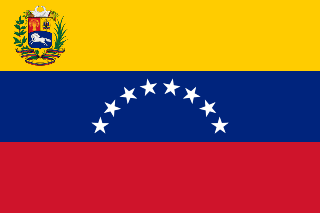Related Research Articles

South America is a continent entirely in the Western Hemisphere and mostly in the Southern Hemisphere, with a relatively small portion in the Northern Hemisphere at the northern tip of the continent. It can also be described as the southern subregion of a single continent called America.
Telecommunications in Suriname includes radio, television, fixed and mobile telephones, and the Internet.

The Arawak are a group of indigenous peoples of northern South America and of the Caribbean. Specifically, the term "Arawak" has been applied at various times to the Lokono of South America and the Taíno, who historically lived in the Greater Antilles and northern Lesser Antilles in the Caribbean. All these groups spoke related Arawakan languages.

The Guiana Shield is one of the three cratons of the South American Plate. It is a 1.7 billion-year-old Precambrian geological formation in northeast South America that forms a portion of the northern coast. The higher elevations on the shield are called the Guiana Highlands, which is where the table-like mountains called tepuis are found. The Guiana Highlands are also the source of some of the world's most well-known waterfalls such as Angel Falls, Kaieteur Falls and Cuquenan Falls.

The South American Football Confederation is the continental governing body of football in South America and it is one of FIFA's six continental confederations. The oldest continental confederation in the world, its headquarters are located in Luque, Paraguay, near Asunción. CONMEBOL is responsible for the organization and governance of South American football's major international tournaments. With 10 member soccer associations, it has the fewest members of all the confederations in FIFA.

The Essequibo River is the largest river in Guyana, and the largest river between the Orinoco and Amazon. Rising in the Acarai Mountains near the Brazil–Guyana border, the Essequibo flows to the north for 1,014 kilometres (630 mi) through forest and savanna into the Atlantic Ocean. With a total drainage basin of 156,828 square kilometres (60,552 sq mi) and an average discharge of 4,531–5,650 cubic metres per second (160,000–199,500 cu ft/s).

The Wapishana or Wapichan are an indigenous group found in the Roraima area of northern Brazil and southern Guyana.

The Trinidad and Tobago national rugby union team has thus far not qualified for the Rugby World Cup, but has participated in qualifying tournaments since 1999. They are classed as a tier-three nation by World Rugby.
As of 2017, South America has an estimated population of 418.76 million people.
The article describes the state of race relations and racism in South America. Racism of various forms is found worldwide. Racism is widely condemned throughout the world, with 170 states signatories of the International Convention on the Elimination of All Forms of Racial Discrimination by August 8, 2006. In different countries, the forms that racism takes may be different for historic, cultural, religious, economic or demographic reasons.

The following outline is provided as an overview of and topical guide to Brazil:

The following outline is provided as an overview of and topical guide to Guyana:

The following outline is provided as an overview of and topical guide to Venezuela:

The following outline is provided as an overview of and topical guide to South America.

Guyana, officially the Co‑operative Republic of Guyana, is a country on the northern mainland of South America. Guyana is an indigenous word which means "Land of Many Waters". The capital city is Georgetown. Guyana is bordered by the Atlantic Ocean to the north, Brazil to the south and southwest, Venezuela to the west, and Suriname to the east. With 215,000 km2 (83,000 sq mi), Guyana is the third-smallest sovereign state by area in mainland South America after Uruguay and Suriname, and is the second-least populous sovereign state in South America after Suriname; it is also one of the least densely populated countries on Earth. It has a wide variety of natural habitats and very high biodiversity.

The borders of Brazil are the international borders that Brazil shares with neighbouring countries. Brazil has terrestrial boundaries with nine countries of South America, and with the French Department of Guiana. Brazil has borders with every country in South America with the exception of Chile and Ecuador, totalling 16,885 kilometres (10,492 mi). Brazil has the world's third longest land border, behind China and Russia.
Telecommunications in Guyana include radio, television, fixed and mobile telephones, and the Internet. Early telecommunications were owned by large foreign firms until the industry was nationalized in the 1970s. Government stifled criticism with a tight control of the media, and the infrastructure lagged behind other countries, Guyana Telephone and Telegraph Company (GT&T) holding a monopoly on most such services. In a 2012 census report on Guyanese households, 55.5% had a radio, 82.7% had a television, 27.8% had a personal computer, and 16.2% had internet at home, 49.3% had a telephone landline, and 70.6% had a cellular phone.

The following is an alphabetical list of topics related to the Co-operative Republic of Guyana.
During the Portuguese colonization of Brazil, homosexuality was illegal in the country between 1533 and 1830, due to the imposition of the Portuguese Penal Code, which was influenced by the British Buggery Act 1533.

The 2010 South American summit, took place in Georgetown, Guyana on November 26, 2010. Eight heads of state and four foreign ministers of the Union of South American Nations attended the summit. During the summit, the leaders signed an additional protocol to the Constitutive Treaty, adding a democratic clause to the charter of the organization. The Georgetown summit ended with the Ecuadorian president handing the UNASUR pro-tempore presidency for the next twelve months to his Guyanese counterpart, Bharrat Jagdeo.
References
- ↑ Newman, Graeme R. (2010-10-19). Crime and Punishment around the World (entry: "Guyana"). ABC-CLIO. p. 189. ISBN 978-0-313-35134-1.
